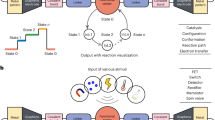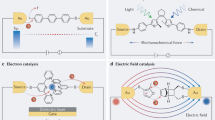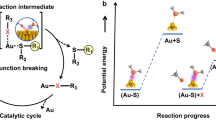Abstract
Conventional analytic techniques that measure ensemble averages and static disorder provide essential knowledge of the reaction mechanisms of organic and organometallic reactions. However, single-molecule junctions enable the in situ, label-free and non-destructive sensing of molecular reaction processes at the single-event level with an excellent temporal resolution. Here we deciphered the mechanism of Pd-catalysed Suzuki–Miyaura coupling by means of a high-resolution single-molecule platform. Through molecular engineering, we covalently integrated a single molecule Pd catalyst into nanogapped graphene point electrodes. We detected sequential electrical signals that originated from oxidative addition/ligand exchange, pretransmetallation, transmetallation and reductive elimination in a periodic pattern. Our analysis shows that the transmetallation is the rate-determining step of the catalytic cycle and clarifies the controversial transmetallation mechanism. Furthermore, we determined the kinetic and thermodynamic constants of each elementary step and the overall catalytic timescale of this Suzuki–Miyaura coupling. Our work establishes the single-molecule platform as a detection technology for catalytic organochemistry that can monitor transition-metal-catalysed reactions in real time.
This is a preview of subscription content, access via your institution
Access options
Access Nature and 54 other Nature Portfolio journals
Get Nature+, our best-value online-access subscription
$29.99 / 30 days
cancel any time
Subscribe to this journal
Receive 12 print issues and online access
$259.00 per year
only $21.58 per issue
Buy this article
- Purchase on Springer Link
- Instant access to full article PDF
Prices may be subject to local taxes which are calculated during checkout






Similar content being viewed by others
Data availability
The datasets used in this work are available online from the Zenodo repository at https://doi.org/10.5281/zenodo.4903414. Source data are provided with this paper.
References
Coontz, R. Not so simple. Science 305, 957–957 (2004).
Barkai, E., Jung, Y. & Silbey, R. Theory of single-molecule spectroscopy: beyond the ensemble average. Annu. Rev. Phys. Chem. 55, 457–507 (2004).
Lu, H. P., Xun, L. Y. & Xie, X. S. Single-molecule enzymatic dynamics. Science 282, 1877–1882 (1998).
Armani, A. M., Kulkarni, R. P., Fraser, S. E., Flagan, R. C. & Vahala, K. J. Label-free, single-molecule detection with optical microcavities. Science 317, 783–787 (2007).
Li, Y., Yang, C. & Guo, X. Single-molecule electrical detection: a promising route toward the fundamental limits of chemistry and life science. Acc. Chem. Res. 53, 159–169 (2020).
Aviram, A. & Ratner, M. A. Molecular rectifiers. Chem. Phys. Lett. 29, 277–283 (1974).
Venkataraman, L. et al. Electronics and chemistry: varying single-molecule junction conductance using chemical substituents. Nano Lett. 7, 502–506 (2007).
Su, T. A., Li, H., Steigerwald, M. L., Venkataraman, L. & Nuckolls, C. Stereoelectronic switching in single-molecule junctions. Nat. Chem. 7, 215–220 (2015).
Miyaura, N. & Suzuki, A. Palladium-catalyzed cross-coupling reactions of organoboron compounds. Chem. Rev. 95, 2457–2483 (1995).
Beletskaya, I. P., Alonso, F. & Tyurin, V. The Suzuki–Miyaura reaction after the Nobel prize. Coord. Chem. Rev. 385, 137–173 (2019).
Thomas, A. A. & Denmark, S. E. Pre-transmetalation intermediates in the Suzuki–Miyaura reaction revealed: the missing link. Science 352, 329–332 (2016).
Thomas, A. A., Wang, H., Zahrt, A. F. & Denmark, S. E. Structural, kinetic, and computational characterization of the elusive arylpalladium(II)boronate complexes in the Suzuki–Miyaura reaction. J. Am. Chem. Soc. 139, 3805–3821 (2017).
Thomas, A. A., Zahrt, A. F., Delaney, C. P. & Denmark, S. E. Elucidating the role of the boronic esters in the Suzuki–Miyaura reaction: structural, kinetic, and computational investigations. J. Am. Chem. Soc. 140, 4401–4416 (2018).
Lennox, A. J. J. & Lloyd-Jones, G. C. Transmetalation in the Suzuki–Miyaura coupling: the fork in the trail. Angew. Chem. Int. Ed. 52, 7362–7370 (2013).
Matos, K. & Soderquist, J. A. Alkylboranes in the Suzuki–Miyaura coupling: stereochemical and mechanistic studies. J. Org. Chem. 63, 461–470 (1998).
Carrow, B. P. & Hartwig, J. F. Distinguishing between pathways for transmetalation in Suzuki–Miyaura reactions. J. Am. Chem. Soc. 133, 2116–2119 (2011).
Amatore, C., Jutand, A. & Le Duc, G. Kinetic data for the transmetalation/reductive elimination in palladium-catalyzed Suzuki–Miyaura reactions: unexpected triple role of hydroxide ions used as base. Chem. Eur. J. 17, 2492–2503 (2011).
Braga, A. A. C., Ujaque, G. & Maseras, F. A DFT study of the full catalytic cycle of the Suzuki–Miyaura cross-coupling on a model system. Organometallics 25, 3647–3658 (2006).
Gu, C. et al. Label-free dynamic detection of single-molecule nucleophilic-substitution reactions. Nano Lett. 18, 4156–4162 (2018).
Guan, J. X. et al. Direct single-molecule dynamic detection of chemical reactions. Sci. Adv. 4, eaar2177 (2018).
Polanyi, J. C. & Zewail, A. H. Direct observation of the transition-state. Acc. Chem. Res. 28, 119–132 (1995).
Xin, N. et al. Concepts in the design and engineering of single-molecule electronic devices. Nat. Rev. Phys. 1, 211–230 (2019).
Li, G. et al. Mechanistic study of Suzuki–Miyaura cross-coupling reactions of amides mediated by [Pd(NHC)(allyl)Cl] precatalysts. ChemCatChem 10, 3096–3106 (2018).
Meconi, G. M. et al. Mechanism of the Suzuki–Miyaura cross-coupling reaction mediated by [Pd(NHC)(allyl)Cl] precatalysts. Organometallics 36, 2088–2095 (2017).
Melvin, P. R., Balcells, D., Hazari, N. & Nova, A. Understanding precatalyst activation in cross-coupling reactions: alcohol facilitated reduction from Pd(II) to Pd(0) in precatalysts of the type (η3-allyl)Pd(L)(Cl) and (η3-indenyl)Pd(L)(Cl). ACS Catal. 5, 5596–5606 (2015).
Zhou, T. et al. [Pd(NHC)(μ-Cl)Cl]2: versatile and highly reactive complexes for cross-coupling reactions that avoid formation of inactive Pd(I) off-cycle products. iScience 23, 101377 (2020).
Balcells, D. & Nova, A. Designing Pd and Ni catalysts for cross-coupling reactions by minimizing off-cycle species. ACS Catal. 8, 3499–3515 (2018).
Cao, Y. et al. Building high-throughput molecular junctions using indented graphene point contacts. Angew. Chem. Int. Ed. 51, 12228–12232 (2012).
Gaudreau, L. et al. Universal distance-scaling of nonradiative energy transfer to graphene. Nano Lett. 13, 2030–2035 (2013).
Rust, M. J., Bates, M. & Zhuang, X. Sub-diffraction-limit imaging by stochastic optical reconstruction microscopy (STORM). Nat. Methods 3, 793–795 (2006).
Marion, N. et al. Modified (NHC)Pd(allyl)Cl (NHC = N-heterocyclic carbene) complexes for room-temperature Suzuki–Miyaura and Buchwald–Hartwig reactions. J. Am. Chem. Soc. 128, 4101–4111 (2006).
Fantasia, S. & Nolan, S. P. A general synthetic route to mixed NHC-phosphane palladium(0) complexes (NHC = N-heterocyclic carbene). Chem. Eur. J. 14, 6987–6993 (2008).
Hruszkewycz, D. P., Balcells, D., Guard, L. M., Hazari, N. & Tilset, M. Insight into the efficiency of cinnamyl-supported precatalysts for the Suzuki–Miyaura reaction: observation of Pd(I) dimers with bridging allyl ligands during catalysis. J. Am. Chem. Soc. 136, 7300–7316 (2014).
Hruszkewycz, D. P. et al. Effect of 2-substituents on allyl-supported precatalysts for the Suzuki–Miyaura reaction: relating catalytic efficiency to the stability of palladium(I) bridging allyl dimers. Organometallics 34, 381–394 (2015).
Melvin, P. R. et al. Design of a versatile and improved precatalyst scaffold for palladium-catalyzed cross-coupling: (η3-1-tBu-indenyl)2(μ-Cl)2Pd2. ACS Catal. 5, 3680–3688 (2015).
Comanescu, C. C. & Iluc, V. M. EH (E = N, O) bond activation by a nucleophilic palladium carbene. Polyhedron 143, 176–183 (2018).
Grushin, V. V. & Alper, H. The existence and stability of mononuclear and binuclear organopalladium hydroxo complexes, [(R3P)2Pd(R′)(OH)]and [(R3P)2Pd2(R′)2(μ-OH)2]. Organometallics 15, 5242–5245 (1996).
Moriya, T., Miyaura, N. & Suzuki, A. Synthesis of allenes by palladium-catalyzed cross-coupling reaction of organoboron compounds with propargylic carbonates: transmetalation of organoboron compounds with (alkoxo)palladium complexes under neutral conditions. Synlett 1994, 149–151 (1994).
Sherwood, J., Clark, J. H., Fairlamb, I. J. S. & Slattery, J. M. Solvent effects in palladium catalysed cross-coupling reactions. Green Chem. 21, 2164–2213 (2019).
Senn, H. M. & Ziegler, T. Oxidative addition of aryl halides to palladium(0) complexes: a density-functional study including solvation. Organometallics 23, 2980–2988 (2004).
Milescu, L. S., Yildiz, A., Selvin, P. R. & Sachs, F. Maximum likelihood estimation of molecular motor kinetics from staircase dwell-time sequences. Biophys. J. 91, 1156–1168 (2006).
Barrios-Landeros, F., Carrow, B. P. & Hartwig, J. F. Effect of ligand steric properties and halide identity on the mechanism for oxidative addition of haloarenes to trialkylphosphine Pd(0) complexes. J. Am. Chem. Soc. 131, 8141–8154 (2009).
Ciampi, S., Darwish, N., Aitken, H. M., Diez-Perez, I. & Coote, M. L. Harnessing electrostatic catalysis in single molecule, electrochemical and chemical systems: a rapidly growing experimental tool box. Chem. Soc. Rev. 47, 5146–5164 (2018).
Shaik, S., Danovich, D., Joy, J., Wang, Z. & Stuyver, T. Electric-field mediated chemistry: uncovering and exploiting the potential of (oriented) electric fields to exert chemical catalysis and reaction control. J. Am. Chem. Soc. 142, 12551–12562 (2020).
Wolfe, J. P., Singer, R. A., Yang, B. H. & Buchwald, S. L. Highly active palladium catalysts for Suzuki coupling reactions. J. Am. Chem. Soc. 121, 9550–9561 (1999).
Yang, C. et al. Electric field-catalyzed single-molecule Diels–Alder reaction dynamics. Sci. Adv. 7, eabf0689 (2021).
Acknowledgements
We acknowledge primary financial support from the National Key R&D Program of China (2017YFA0204901), the National Natural Science Foundation of China (21727806, 21933001 and 21772003) and the Tencent Foundation through the XPLORER PRIZE. The research at UCLA was supported by the US National Science Foundation (CHE 1764328). S.Z. and Z.L. appreciate the support from the High-Performance Computing Platform of the Center for Life Science at Peking University.
Author information
Authors and Affiliations
Contributions
X.G., F.M. and K.N.H. conceived and designed the experiments. C.Y., L.Z. and Yu Li fabricated the devices and performed the device measurements. L.Z. carried out the molecular synthesis. C.L., S.Z., X.L., Yanwei Li, Z.L. and J.Y. built and analysed the theoretical model and performed the quantum transport calculations. X.G., F.M., K.N.H., Y.Y., C.Y. and L.Z. analysed the data and wrote the paper. All the authors discussed the results and commented on the manuscript.
Corresponding authors
Ethics declarations
Competing interests
The authors declare no competing interests.
Additional information
Peer review information Nature Nanotechnology thanks Nadim Darwish, Albert Poater and the other, anonymous, reviewer(s) for their contribution to the peer review of this work.
Publisher’s note Springer Nature remains neutral with regard to jurisdictional claims in published maps and institutional affiliations.
Supplementary information
Supplementary Information
Supplementary Sections 1–16, Figs. 1–39 and Tables 1–5.
Supplementary Data 1
Supplementary source data and original figures including compounds 1–3, Scheme 1, Figs. 1–39 and Tables 1–5.
Supplementary Video 1
Highly correlated fluorescent and current signals of the single-molecule catalyst site during the Suzuki–Miyaura cross-coupling.
Source data
Source Data Fig. 1
Original NMR data.
Source Data Fig. 2
Statistical source data and original figures.
Source Data Fig. 3
Statistical source data.
Source Data Fig. 4
Statistical source data.
Source Data Fig. 6
Statistical source data.
Rights and permissions
Springer Nature or its licensor (e.g. a society or other partner) holds exclusive rights to this article under a publishing agreement with the author(s) or other rightsholder(s); author self-archiving of the accepted manuscript version of this article is solely governed by the terms of such publishing agreement and applicable law.
About this article
Cite this article
Yang, C., Zhang, L., Lu, C. et al. Unveiling the full reaction path of the Suzuki–Miyaura cross-coupling in a single-molecule junction. Nat. Nanotechnol. 16, 1214–1223 (2021). https://doi.org/10.1038/s41565-021-00959-4
Received:
Accepted:
Published:
Issue Date:
DOI: https://doi.org/10.1038/s41565-021-00959-4
This article is cited by
-
Total variation denoising-based method of identifying the states of single molecules in break junction data
Discover Nano (2024)
-
Regulation of quantum spin conversions in a single molecular radical
Nature Nanotechnology (2024)
-
The role of phosphines in the activations of coupled substrates in the Suzuki—Miyaura reaction
Russian Chemical Bulletin (2024)
-
Advances in single-molecule junctions as tools for chemical and biochemical analysis
Nature Chemistry (2023)
-
Real-time monitoring of reaction stereochemistry through single-molecule observations of chirality-induced spin selectivity
Nature Chemistry (2023)



